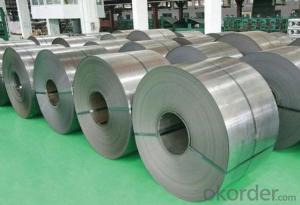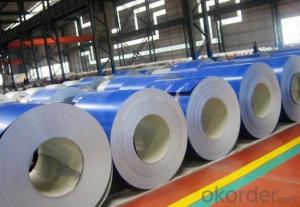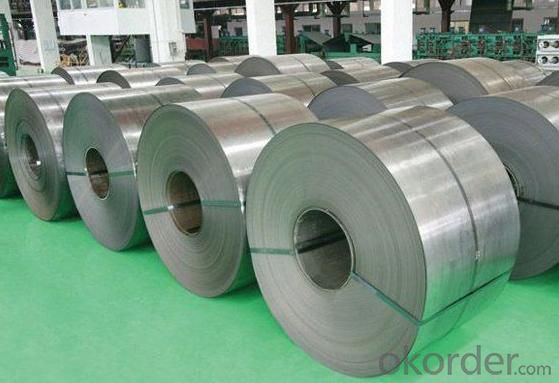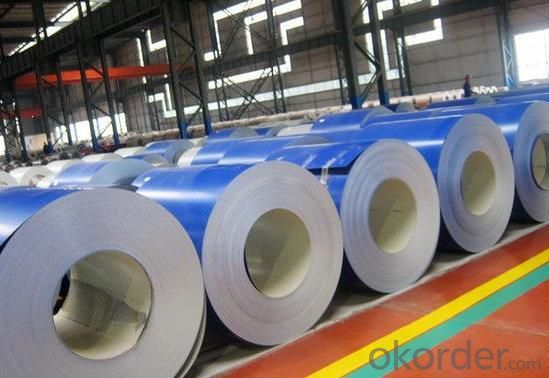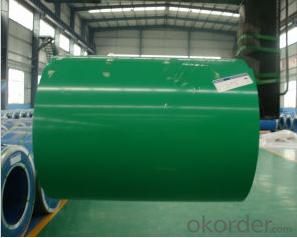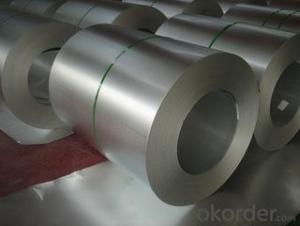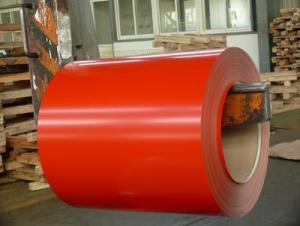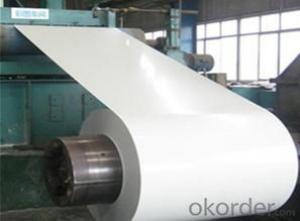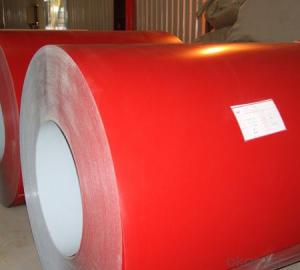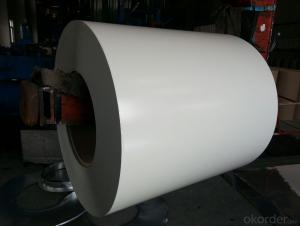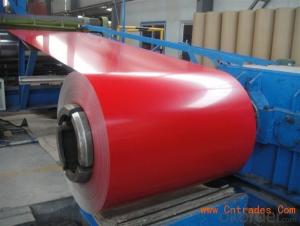Competitive Prepainted Galvanized Steel Coil for Steel Structure Buildings
- Loading Port:
- Shanghai
- Payment Terms:
- TT OR LC
- Min Order Qty:
- 30 m.t.
- Supply Capability:
- 10000 m.t./month
OKorder Service Pledge
OKorder Financial Service
You Might Also Like
Basic Info.
Model NO.:CGCC, SGCC, DX51D, DX51D+Z, TDC51D, TDC51D+Z, G550
Surface Treatment:Coated
Certification:ISO, SGS, BV
Technique:Hot Rolled
Standard:ASTM, JIS, GB, AISI, DIN, BS
Application:Building Material, Steel Structure Buildings
Edge:Mill
Stock:Stock
Steel Grade:Q195
Thickness:0.12-1.5mm
Width:600-1500mm
Zinc Coating:30g-275G/M2
Color:as Ral or Sample
Paint Thickness:Top 15-25um+Back 8-10um
Painting Type:PE, PVDF, Smp, Hdp, as Requested
Delivery Day:15-30 Days
Production Ability:30000mt/Month
Coil Weight:3-5 Ton
Export Markets:Global
Additional Info.
Packing:Sthandar Seaworthy Package
Standard:JIS G3302-1998/EN10142/ASTM
HS Code:72107010
Production Capacity:30000mt/Month
Product Description
NAME: Competitive prepainted galvanized steel coil for building
SIZE:
Thickness: 0.12-1.5mm
Width: 600mm,750mm,762mm,900mm,914mm,940mm,1000mm,1050mm, 1090mm,1100mm,1200mm, 1219mm, 1250mm,1250mm
Length: According to the customer's request
Hardness:Soft( around HRB 65) ,full hard (HRB90-95)
Strength of Extension: more than 300Mpa
Yield Strength:370-380Mpa
Thickness tolerance: +/-0.02 mm(0.01 as you requested)
Width tolerance:+/ -2.0mm
ZINC, PAINT & COLOR:
Zinc coating: 30-275G/M2
Paint thickness: Top 15-25um + Back 8-10um
Paint: Epoxy Polyester, silicon modified polyesters, polyvinylidene fluoride, high-durability polyester
| Base mental | hot galvanized /galvalume steel coil |
| Thickness | 0.12-1.5mm |
| Width | 600-1500mm |
| Coil Weight | 3-5ton |
| Quality: | DX51D DQ CQ |
| Color | all RAL colors or as per customers' sample |
| Zinc-coating | 30g/m2-275g/m2 |
| Coil ID | 508mm-610mm |
| Packing | standard seaworthy package |
| Technique | cold rolled, hot-dipped galvanizing, color coated |
| Painting | Top and bottom: 20mic+5mic RMP Back: 8mic-10mic |
| Tolerance | Thickness: +/-0.02mm Width: +/-2mm |
| Description | Pre-painted Steel Coil uses hot galvanized steel as its basic material, factory adopts advanced equipment to degrease, rinse, transform the galvanized steel, then make primary and refined lavation to the steel coils. |
| application | They are mainly applied for steel structure buildings, household appliance, furniture, transportation and other industries |
| feature | Pre-painted Steel Coils have excellent performance of decoration, corrosion resistance etc. |
| The special order can be negotiated | |
- Q: What are the different coil cutting methods used for steel coils?
- Various methods are commonly employed for cutting steel coils, each boasting its own unique advantages and applications. Among these techniques are shearing, slitting, and laser cutting. 1. Shearing: By applying substantial force to a set of blades, shearing effectively slices through steel coils in a straight line. This method is highly suitable for reducing the size of thick steel coils into more manageable dimensions. Not only is shearing cost-effective, but it is also well-suited for high-volume production. 2. Slitting: Slitting involves the process of dividing a wide coil into multiple narrower strips. This approach is frequently utilized for steel coils that require various widths, such as those used in the fabrication of automotive components, construction materials, and electrical appliances. Slitting machines utilize circular knives to execute precise cuts, ensuring minimal material loss and achieving high levels of accuracy. 3. Laser cutting: Laser cutting represents a more advanced technique wherein a high-powered laser beam is employed to sever steel coils. This method provides exceptional precision, allowing for intricate designs and complex shapes to be effortlessly cut. Laser cutting is particularly suitable for steel coils of thin to medium thickness and is frequently employed in industries that demand superior cuts, such as automotive, aerospace, and electronics. Each of these coil cutting methods possesses unique merits and is selected based on the specific requirements of the steel coils being processed. Factors including coil thickness, desired accuracy, production volume, and the complexity of required cuts are all taken into consideration when determining the most appropriate cutting method.
- Q: Steel sticks- it has meaning to us -similar to my deceased father's name, Steven fits our style as people. We like the hardness of it for our little man. We need a middle name though. Open to suggestions, thank you=)
- Steel ___ Tompkins xavier jax stone blaise/blaze navarro dialo zorion soloman eron muron darko vincent wolf giovanni ryker/rykeir orvall oryan/orian isadore reese axel/axl xander/zander zane zeke dane xan/zan grayson griffin trayton urban sterling - probably wouldn't sound good with steel but its another choice you can have STOP HATING SHE SAID SHE DIDNT LIKE COMMON NAMES!
- Q: How are steel coils protected during transportation?
- Steel coils are typically protected during transportation by being wrapped in layers of protective materials such as plastic or paper, and then secured onto pallets or placed inside specialized containers. This helps prevent damage from moisture, dust, and other external elements, ensuring the coils arrive at their destination in good condition. Additionally, proper handling and loading techniques are employed to minimize the risk of any physical damage during transportation.
- Q: Can someone help me...i have a diagram and were supposed to calculate the steel tonnage needed for the pictre. Can someone tell me step by step what i need to do (ex:find area of ...)
- - Find the cross sectional area of the steel bars if given, if not find the volume of concrete and approximately multiply the concrete volume by 400kg the weight of steel per concrete volume. - If you find the steel cross sectional area , multiply by the
- Q: What are the common coil grades available for steel coils?
- The common coil grades available for steel coils are typically classified into three main categories: low carbon steel, medium carbon steel, and high carbon steel.
- Q: I have a steel garage, it looks worn out hauled away? How can I maintain / repair it?
- The entire garage is steel? Garage door? Are you able to open and close it without too much trouble? If so, just keep it lubricated. You could paint the door to improve its appearance.
- Q: Is boron steel or carbon steel a harder metal? Which one is more flexible?
- There is really no simple answer to this question. Boron is usually used for a handful of reasons, but most center on high volume low cost production of durable hardened steel. Boron is a very cheap way to get very durable parts with very minimal alloying of expensive materials. It was born of necessity during WW2 and is currently in WIDE use in bulldozer undercarriage. Probably in place of what would otherwise be 4140. Boron steel is quite a bit more difficult to properly heat treat. Better suited to mass production facilities with tight controls, but when done properly provides material just as durable as higher alloys. Not a backyard endeavor such as ht/tempering carbon steel or tool steels without appropriate homework and treatment controls.
- Q: Can steel coils be coated with light-reflective materials?
- Yes, steel coils can be coated with light-reflective materials.
- Q: How do steel coils contribute to the sustainability of construction projects?
- There are several ways in which steel coils contribute to the sustainability of construction projects. First and foremost, steel is a highly durable and long-lasting material. Manufactured to withstand extreme weather conditions, corrosion, and other external factors, steel coils are ideal for construction projects that require strength and longevity. This durability reduces the need for frequent repairs and replacements, resulting in minimized waste and resource consumption over time. Moreover, steel coils are recyclable. Once their lifespan in a construction project comes to an end, steel coils can be easily and efficiently recycled. This recycling process requires less energy compared to the production of new steel, leading to reduced carbon emissions and environmental impact. Furthermore, the recycled steel can be utilized in various industries, including construction, thereby promoting sustainability and resource conservation. Additionally, steel coils contribute to the sustainability of construction projects by offering design flexibility. Being a versatile material, steel can be easily shaped, cut, and molded into different forms and sizes. This allows for efficient construction practices, reducing material wastage and optimizing resource utilization. Furthermore, the lightweight nature of steel coils enables convenient transportation and installation, further decreasing fuel consumption and associated greenhouse gas emissions. Lastly, steel coils contribute to the sustainability of construction projects through their energy efficiency. Being an excellent conductor of heat and electricity, steel is ideal for energy-efficient buildings. By incorporating steel coils into the construction of walls, roofs, and other components, buildings can be effectively insulated, resulting in reduced energy consumption for heating and cooling. Consequently, occupants benefit from lower energy bills, while the overall carbon footprint of the construction project is reduced. In conclusion, steel coils contribute to the sustainability of construction projects through their durability, recyclability, design flexibility, and energy efficiency. By utilizing steel coils, construction projects can minimize waste, conserve resources, reduce environmental impact, and optimize energy consumption, thereby promoting a more sustainable and eco-friendly approach to construction.
- Q: What are the common applications of galvalume steel coils?
- Galvalume steel coils have a wide range of applications due to their unique properties and durability. Some common applications of galvalume steel coils include: 1. Roofing: Galvalume steel coils are commonly used in the construction industry for roofing applications. The coating on these coils provides excellent corrosion resistance, making them ideal for protecting roofs from harsh weather conditions and extending their lifespan. 2. Siding: Galvalume steel coils are also used for siding applications in residential, commercial, and industrial buildings. The durability of these coils makes them suitable for withstanding external elements, such as rain, wind, and sunlight, without corroding or deteriorating. 3. Gutters and Downspouts: Galvalume steel coils are extensively used in gutter and downspout systems. The corrosion-resistant properties of these coils ensure that gutters and downspouts remain functional and aesthetically pleasing for a longer period, saving homeowners from frequent replacements or repairs. 4. Appliances: Many household appliances, such as refrigerators, ovens, and washing machines, utilize galvalume steel coils. The corrosion resistance and high heat reflectivity of these coils make them an excellent choice for manufacturing durable and energy-efficient appliances. 5. Automotive Industry: Galvalume steel coils find applications in the automotive industry for manufacturing parts like body panels, chassis, and exhaust systems. The lightweight nature and corrosion resistance of these coils contribute to fuel efficiency and the overall durability of vehicles. 6. HVAC Systems: Heating, ventilation, and air conditioning (HVAC) systems often use galvalume steel coils for components like ductwork and air handling units. The coils' ability to withstand high temperatures and resist corrosion ensures the longevity and efficiency of HVAC systems. 7. Agricultural Equipment: Galvalume steel coils are used in the manufacturing of agricultural equipment, such as grain storage bins, barns, and sheds. These coils provide excellent protection against rust, ensuring that the equipment remains durable and reliable in agricultural environments. Overall, galvalume steel coils have a wide range of applications across various industries due to their corrosion resistance, durability, and ability to withstand harsh environmental conditions.
Send your message to us
Competitive Prepainted Galvanized Steel Coil for Steel Structure Buildings
- Loading Port:
- Shanghai
- Payment Terms:
- TT OR LC
- Min Order Qty:
- 30 m.t.
- Supply Capability:
- 10000 m.t./month
OKorder Service Pledge
OKorder Financial Service
Similar products
Hot products
Hot Searches
Related keywords
